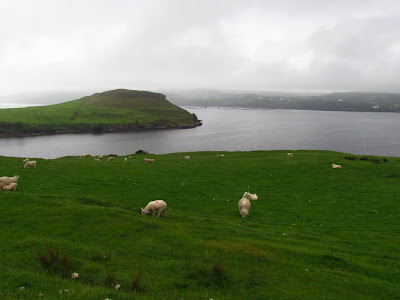Today we drove to Elgol in the southern part of the Isle of Skye through the fog and alpine mountains.
We then drove to the northern part of the Island to Dunvegan Castle & Gardens built on a rocky outcrop on the shores of Loch Dunvegan once entirely encircled by the sea, Dunvegan is the oldest continuously inhabited castle in Scotland and has been the ancestral home of the Chiefs of Clan MacLeod for 800 years. The most famous of items at the castle is the Fairy Flag. Legend has it that this sacred Banner has miraculous powers and when unfurled in battle, the clan MacLeod will defeat their enemies. The precious Fairy Flag of Dunvegan, the most treasured possession of the Clan, is just such a relic ...The traditional tales about its origin, some of them very old indeed, have two themes - Fairies and Crusaders. Fairy stories involve a baby being left in the turret and when checked on by the maid, the baby was wrapped in the Faery Flag and a faery held her singing to her before putting her down and leaving. The connection with the Crusades can, however, be linked to the only definite information available as to the origin of the Fairy Flag - the fabric, thought once to have been dyed yellow, is silk from the Middle East (Syria or Rhodes); experts have dated it between the 4th and 7th centuries A.D., in other words, at least 400 years before the First Crusade. So was it the robe of an early christian saint? Or the war banner of Harold Hardrada, King of Norway, killed in 1066, or did it emerge mysteriously from some grassy knoll in Skye? We did actually view what is left of this very fragile piece of fabric whilst in the castle. Dunvegan Castle’s five acres of formal gardens began life in the 18th century. In stark contrast to the barren moorland and mountains that dominate Skye’s landscape, the gardens are a hidden oasis featuring an eclectic mix of plants, woodland glades, shimmering pools fed by waterfalls and streams flowing down to the sea. The Water Garden with its ornate bridges and islands replete with a rich and colourful plant variety, and the elegant surroundings of the formal Round Garden featuring a Box-wood Parterre as its centrepiece and the Walled Garden was formerly the castle’s vegetable garden, is now a diverse range of plants and flowers that complement the attractive landscaped features including a water lily pond, a neoclassical urn and a Larch Pergola. The faery bridge and faery glen in the gardens were absolutely glorious.

























No comments:
Post a Comment